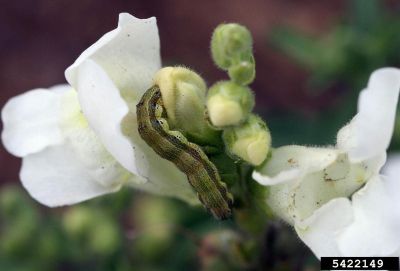What are Budworms?
Budworms are moth caterpillars that chew their way into the tightly coiled buds of flowers and slowly eat them from the inside out. Budworm caterpillars start life as tiny larvae that measure less than 1/16 inch (1.5 ml.) long, but grow up to 2 inches (5 cm.) over the course of the summer. These larvae start out cream colored with brown heads and light colored stripes, but mature into colors ranging from green to rust to black. Identification should be simple — they’ll be the caterpillars eating your flowers from the inside out. Budworms feed on all types of vegetative buds, but primarily focus on flower buds and maturing ovaries. Flower buds often fail to open, but those that do look ragged from all the petal chewing. As the summer progresses, the damage gets more severe. Fortunately, these pests only feed for about a month before dropping into the soil to pupate, giving your flowers a chance to recover. Two generations a year are common, with the second generation being much more damaging than the first.
How to Kill Budworms
Controlling budworms is all about timing. Since the larvae spend most of their time protected by the buds where they feed, treatment after hatching does little good to destroy populations. Instead, applying pesticides before hatching or to newly emerged caterpillars is the best solution. Synthetic pesticides like permethrin, esfenvalerate, cyfluthrin, and bifenthrin require fewer applications because they last longer in the environment, but they can be dangerous to beneficial insects like bees, especially if part of your flower garden is already in bloom. Bacillus thuringiensis (Bt) can be used safely against budworms, but timing is everything. Monitor your plants carefully for larval emergence and apply Bt as soon as the first few eggs start to hatch. Bt has a very short life when exposed to air, but it will target the caterpillars without damaging other insects. Other, safer methods of control include checking buds for tiny holes and removing those that are infected in hopes of breaking the life cycle. Cold winters are believed to be devastating to pupating budworms, allowing potted plants to experience temperatures of 20 F. (-6 C.) and lower can reduce the next season’s budworm population.
